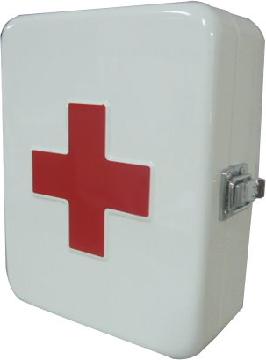This really is a prepping 101 type of post. In fact, having a propper first aid kit on hand is one of the most popular pieces of advice given to new preppers. Unfortunately, many will head out to Costco, or their other favorite retailer and pick up a prepared kit, thinking they have that area resolved and dealt with. Most of these kits are woefully under stocked and really won’t do much more than take care of the occasional cut or scrape. As someone who spent years acting as a workplace first aider, with regular retraining, I’ve become acustomed to a kit stocked up with very specific amounts of consumables. Here is how I set up my kit.

The kit I prefer is one recommended by the Quebec government for workplaces of 26 to 50 employees. It is considered the “medium” kit and there are a few reasons I choose to stock my home kit in this way. The first reason is that this is the kit I was trained to use and oversee. As a workplace first aider, it was not just my responsibility to administeraid, but also to manage the stocking of the various kits around the company. Most of what I had to deal with were very minor lacerations. Being a printing company, paper cuts were a popular issue. Being an industrial setting however, there were much more serious injuries, up to and including a coworker getting a hand stuck in an industrial sized printing press. The kit I used was able to take care of both types of injuries, and anything in between.
I feel the need to refer back to the first paragraph about understocked kits. In doing some searches for this post, I saw many results where retailers would claim “Quebec approved”. However, looking through the actual government site, I noticed that they claimed that there were no certified or approved kits. Keep that in mind if you decide to go with a prepackaged kit.
Alright, I hear you. Enough yapping…just get to the contents. Here it is:
| Adhesive bandages, sterile, assorted sizes (standard, large, fingertip, knuckle, patch) | 50 |
|---|---|
| Conforming stretch bandages, relaxed length, individually wrapped, 5.1 cm x 1.8 m (2 inches x 2 yards) | 2 rolls |
| Conforming stretch bandages, relaxed length, individually wrapped, 7.6 cm x 1.8 m (3 inches x 2 yards) | 2 rolls |
| Bandage scissors | 1 pair, stainless steel (angled blunt tip), minimum 14 cm (5.5 inches) |
| Gauze pads, sterile, individually wrapped, 10.2 cm x 10.2 cm (4 inches x 4 inches) | 24 |
| Compresses/pressure dressings with ties, sterile, 10.2 cm x 10.2 cm (4 inches x 4 inches) | 2 |
| Triangular bandage, cotton, with 2 safety pins, 101.6 cm x 101.6 cm x 142.2 cm (40 inches x 40 inches x 56 inches) | 4 |
| Antiseptic wound cleansing towelettes, individually wrapped | 50 |
| Splinter forceps/tweezers | 1, fine point, stainless steel, minimum 11.4 cm (4.5 inches) |
| Adhesive tape, 2.5 cm, 1 inch | 4,6 m |
| Cold compresses (cold pack), instant (or equivalent) | 2 |
| Cardiopulmonary resuscitation (CPR) barrier device with one-way valve | 1 |
| Examination gloves, disposable | 8 pairs, medical grade, one size, non-latex, powder free |
| Splint, padded, malleable, minimum 10.2 cm x 61 cm (4 inches x 24 inches) | 1 |
| Abdominal pads, sterile, individually wrapped, 12.7 cm x 22.9 cm (5 inches x 9 inches) | 2 |
| Gauze pads, sterile, individually wrapped, 7.6 cm x 7.6 cm (3 inches x 3 inches) | 12 |
| Compresses/pressure dressings with ties, sterile, 15.2 cm x 15.2 cm (6 inches x 6 inches)m (4 inches x 4 inches) | 2 |
| Glucose tablets, 4 g (10 per pack) or acceptable alternative (hard candy, orange juice or other juices with fructose) | 2 packs |
| Emergency Mylar rescue blanket, non-stretch polyester, minimum 132 cm x 213 cm (52 inches x 84 inches) | 2 |
| Arterial tourniquet | 1 |
| Hand and skin cleansing towelettes, individually wrapped (or equivalent) | 12 |
| Antibiotic ointments, topical, single use | 12 |
| Elastic support and compression bandages/dressings, relaxed length, individually wrapped, 7.6 cm (3 inches) | 2 |
| Non-adherent dressings, sterile, individually wrapped, 5.1 cm x 7.6 cm (2 inches x 3 inches) | 8 |
| Biohazard waste disposal bag, single use | 4 |
| Eye pad dressings, sterile, and eye shield with elastic strap | 2 sets |
| Contents list | 1 |
This kit, properly stored in a clearly marked container (medical bag, metal FA box, etc.) will take care of most issues arrising in the average home very well. For a longer term kit should you find yourself in a situation where medical help is not an option, you may want to increase the quantity of anything made of gauze. Think double or triple at minimum. These extra items could also be stored in a backup inventory container and used to restock the kit as needed.
Of course, in an industrial setting, there are usually additional supplies or equipment not contained within the kit itself. One example of this would be an eye wash station. Eye washers are available and should be considered. Also, you may want to expand your first aid preparedness by including items that would be found in a dedicated first aid room. These are:
- 1 stretcher
- 1 table and 2 chairs
- Soap and 1 nail brush
- Paper to wipe hands
